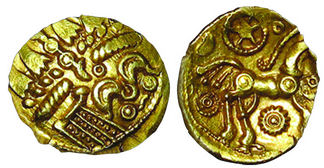
The "Tring Wheel" is so called because the first known specimen was discovered at Tring, Hertfordshire – the coin is a gold quarter stater minted in the mid first century B.C.E., around the time Julius Caesar raided Britain. The obverse shows a stylized head of the sun-god Apollo (can you see the hidden face with huge eyebrows?). The reverse displays a three-tailed sun-horse with a spoked sun-wheel above and a sunburst below. Only nine other examples of the Tring Wheel have been recorded, including one in the National Museum of Wales; the British Museum does not have one in its collection.
Dr John Sills, co-author of Ancient British Coins (Chris Rudd 2010), says: “The Tring Wheel type is a North Thames version of British Qc, one of a short series of Qc variant copies struck somewhere between the Trinovantes and the Catuvellauni in the Essex/Herts region. The Tring Wheel type is extremely rare and an early issue, probably around 55-45 B.C. The rarity and coherence of the group in general suggest it may have been struck by a small unknown tribe rather than by the Trinovantes or Catuvellauni.”
The above example was found by a metal detectorist near Caister, Lincolnshire, in 2010, and the above information comes from an article on Numismaster.com reporting on the planned sale by auction Nov. 10, 2014, by the firm Chris Rudd. Another example came to auction earlier in 2014 and was estimated at £600-£800
| October 2014 | Page Created | |